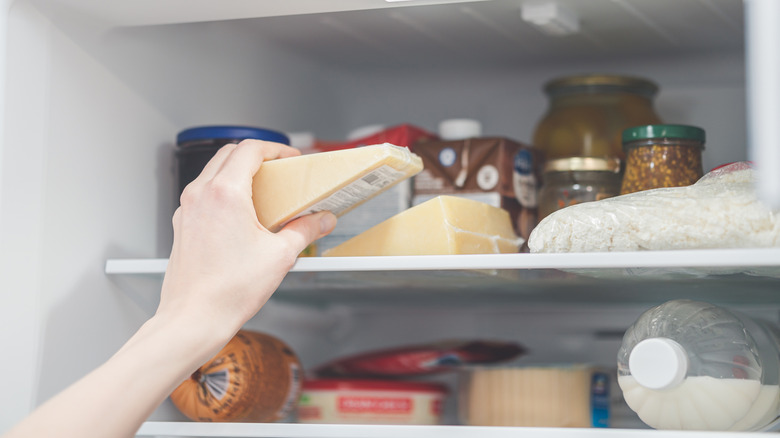The Best Way To Store Parmesan Cheese In The Fridge
We may receive a commission on purchases made from links.
If you've got a wedge of authentic Parmesan cheese, it's likely been carved from a large wheel that was stored in optimal conditions. But once you've taken possession, to preserve the rich, nutty, and umami notes of your block, it is imperative to store it correctly. Improper storage may result in the cheese losing its aroma and texture or, worse, going bad, which is a heartbreaking prospect for any foodie.
Fortunately, this is a hard, low-moisture cheese with a relatively long shelf life. In fact, the original Parmigiano Reggiano was formulated in the Middle Ages with longevity in mind so that the cheese could be preserved for extended periods. Even now, a sealed block of Parmesan can last for about nine months. Once opened, you need to protect it from changes in humidity and temperature by keeping it refrigerated. Parmesan cheese must also be stored in a breathable material like parchment paper or cheesecloth to avoid condensation from building up around the cheese, which can result in mold. If you see any fungal growth on your Parmesan, you'll have to trim off the affected parts to salvage the rest.
Parmesan cheese needs to breathe, so avoid plastic wrapping
Unless it's vacuum packed, cheese gives off a small amount of moisture, which can turn into condensation if there is nowhere for it to escape. Storing Parmesan in a sealed plastic bag or covering it in film will result in moisture buildup, speeding up spoilage. Instead, the best way to store Parmesan is to fold it in wax paper. Make sure all the surfaces of the cheese are covered so it doesn't dry out, while the paper will also avoid any condensation from forming. Parchment paper and cheesecloth are also viable options, and Parmesan cheese is best stored at temperatures between 40 and 45 degrees Fahrenheit.
While the paper wrapping helps manage humidity, it doesn't protect Parmesan from stray refrigerator smells; a dedicated cheese box can help with this. Or else, you can add a layer of aluminum foil around the paper-wrapped block of cheese. Ensure the foil is tightly wrapped so the fat in your Parmesan cheese doesn't absorb unwanted odors. Alternatively, you can store the paper-wrapped cheese in an oversized sealed plastic bag that's big enough to let the cheese breathe. When stored using these methods, a piece of Parmesan remains unspoiled in the fridge for two to four weeks. Remember that the maturity of the cheese also affects its shelf life. A block aged for 24 months will have less moisture and will, therefore, stay unspoiled for longer.
Freeze Parmesan cheese only as a last option
Freezing cheese is generally not recommended as it can affect the texture, especially in moisture-rich cheeses like ricotta or young cheddar. If you plan on using it on a cheese charcuterie board or anywhere else where it'll be eaten raw, you should avoid freezing Parmesan cheese as its texture will turn crumbly and dry. However, if it's destined to be cooked and melted into dishes, then its texture is not as crucial, and you can consider freezing Parmesan in an airtight container for up to six months. Once it's thawed, however, you cannot freeze it again.
One great way to store that rich flavor for extended periods is freezing leftover rind from used parmesan blocks in an airtight bag. You can use parmesan rind to upgrade sauces by simply dropping it into the pot to infuse flavor and then discarding the rind before serving.
If freezing is the only option, vacuum sealing your cheese before storing it in the freezer can help retain its flavor. You can also consider double bagging or wrapping the cheese in an additional layer of foil to avoid freezer burn and stray odors from getting in. In general, a block of Parmesan will also last slightly longer in the freezer than a grated version of the block. Finally, a slow thaw can help it regain some of its texture, so let your frozen Parmesan spend a day or two in the fridge before using it.


